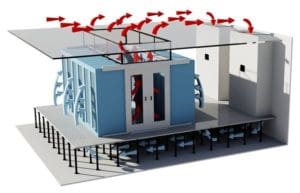Cooling best practices are essential for maximising the efficiency and longevity of your data centre. By implementing smart airflow management strategies and using high-quality solutions like EziBlank blanking panels, you can dramatically reduce your energy consumption while ensuring optimal system performance. Don’t let inefficiencies drain your resources; invest in our innovative products to take control of your cooling processes and secure significant savings. Join countless satisfied customers who have transformed their facilities and reap the benefits of a smarter, leaner operation today!
Data Center Cooling: Best Practices
Implementing best practices for data centre cooling is crucial to maintaining efficiency, reducing energy costs, and ensuring the longevity of equipment. Key practices include optimising airflow by using blanking panels to fill unused rack spaces, which prevents hot air recirculation and ensures that cool air reaches the servers effectively. Additionally, employing hot and cold aisle containment systems can further enhance cooling efficiency by separating hot exhaust air from cold intake air, reducing the workload on cooling systems. Regular maintenance of HVAC systems and air filters is essential to ensure that cooling units operate at peak performance. Monitoring temperature and humidity levels in real-time allows for adjustments that prevent overheating and ensure optimal conditions. By following these best practices, data centres can achieve significant improvements in cooling efficiency, leading to lower operational costs and improved equipment performance.
Read More
Hot Aisle Containment Solutions & Products
Hot aisle containment solutions typically include barriers, doors, and ceiling panels that effectively seal off the hot aisle, creating a controlled environment where the separation of hot and cold air is meticulously maintained. This separation ensures that hot exhaust air is directed away from the servers and into return air ducts, preventing it from mixing with the cool intake air and thereby enhancing the efficiency of the cooling system. Implementing these solutions not only significantly reduces energy consumption and lowers cooling costs but also enhances the overall performance, reliability, and lifespan of the data centre’s infrastructure, making it a vital strategy for modern data centres aiming to optimise their operations.
Read More
What is Cold Aisle Containment
Cold aisle containment is a data centre cooling strategy designed to improve energy efficiency and optimise temperature control. In this setup, the cold aisle, where the fronts of the server racks are located, is enclosed to prevent the mixing of cold air with the hot exhaust air from the servers. This containment system ensures that the cool air from the air conditioning units is directed exclusively towards the servers' intake, maximising cooling efficiency. By containing the cold aisle, data centres can maintain lower temperatures with less energy, reducing the workload on cooling systems and lowering overall energy consumption. This approach not only improves the performance and reliability of the equipment but also contributes to significant cost savings and a more sustainable data centre operation. Cold aisle containment is particularly effective in high-density data centres where cooling demands are substantial.
Read MoreWhat is Hot Aisle Containment
Hot aisle containment is a cooling strategy used in data centres to improve energy efficiency by isolating the hot air generated by servers. In this setup, the hot aisle, where the backs of the servers expel warm air, is enclosed, preventing the hot air from mixing with the cool air in the rest of the data centre. This containment ensures that the hot air is directed straight to the cooling units, where it is removed or recycled, thereby reducing the workload on the cooling system. By maintaining a clear separation between hot and cold airflows, hot aisle containment helps to lower energy consumption, enhance cooling efficiency, and maintain optimal operating conditions for the servers, making it a crucial strategy for modern data centre management.
Read More
The Basics of Airflow Management
Airflow management is a fundamental aspect of data centre design that focuses on optimising the cooling process to ensure that IT equipment operates efficiently and reliably. The primary goal is to prevent the mixing of hot and cold air within the data centre, which can lead to hotspots and inefficient cooling. Key strategies include the use of blanking panels to seal off unused rack spaces, directing cool air to where it’s needed most and preventing hot air from recirculating. Additionally, hot and cold aisle containment systems are employed to physically separate the cold intake air from the hot exhaust air, further improving cooling efficiency. Effective airflow management reduces the energy required for cooling, lowers operational costs, and enhances the overall performance and lifespan of data centre equipment.
Read More
